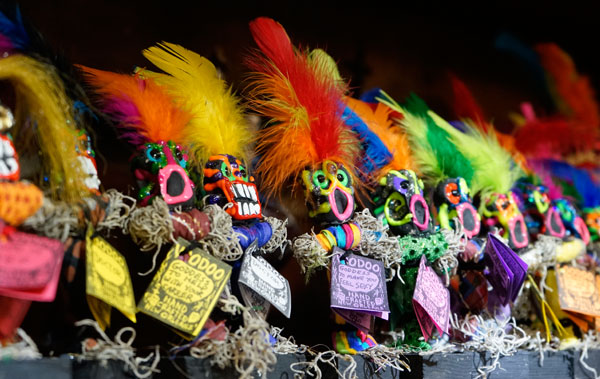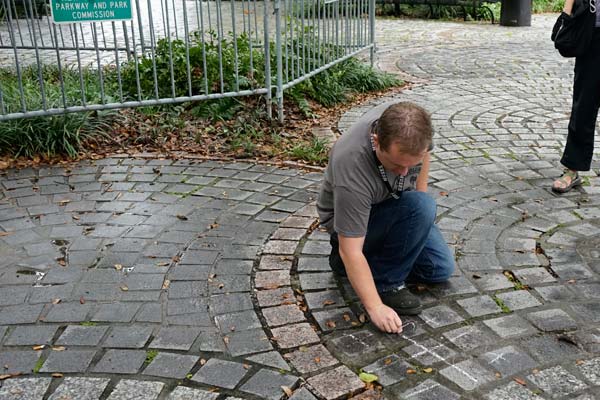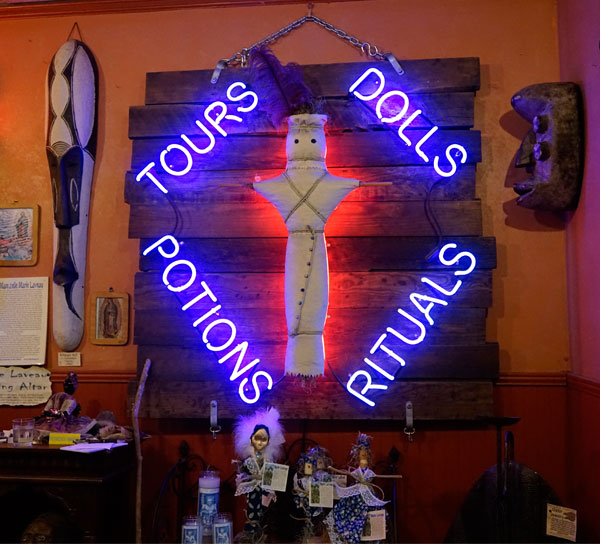
If you’ve ever been to New Orleans then you most certainly have seen voodoo dolls for sale by the bundles in almost every store. They’re hard to miss, right next to the other campy tourist souvenirs like shot glasses, carnival masks and alligator hand keychains. But if you look a little deeper, and take the time to research, you will discover a religion with an interesting history that is very much alive and still being practiced in this area of our country. I’m talking about Voodoo. Now I know the word conjures up images of Hollywood movies or old stories of curses and death, but there is another part of this religion that you may not be aware of. When I was in New Orleans, I took a Voodoo Tour. We visited historic locations, learned about the history of Voodoo in New Orleans and even visited an authentic Voodoo temple. That wasn’t all…we learned all about Marie Laveau, the “Voodoo Queen of New Orleans”. Join me now as I share with you all that I learned on this Voodoo Tour.
Under the Code Noir (Black Code) implemented by King Louis XIV, slaves under the French colonial empire were given only one day off a week from their usual duties. So on Sundays, they would gather just outside the city at a place now called Congo Square located within Louis Armstrong Park in New Orleans. Away from their masters, they enjoyed the freedom to sing, laugh, dance, and co-mingle with each other. However, there were some things that were forbidden by law, such as the practice of other religions. The slaves outnumbered the masters by a large margin. They would form social circles that were so numerous, it made it hard for slave owners to really see what was going on from the gates of the city. The picture below is Congo Square today. The large circle in the center is where an old tree stump used to be. It was at this location that slaves would practice the forbidden religion of Voodoo, a religion brought over and spread by West African and Haitian slaves.

As our tour guide, James, taught us about the origins of the religion and how it grew in the city of New Orleans, he assured us that it is still practiced today among many people in the area including himself. He then shared some of the Voodoo rituals beginning with the drawing of a “veve” on the ground. Below you can see him drawing with chalk the symbol that in the Voodoo religion, acts as a beacon or gateway for the Loa (or spirit) that is summoned. It was commonly drawn on the floor with a type of cornmeal or some sort of powder.

Here is an example of a more elaborate drawing just outside of one of the Voodoo temples in the French Quarter.

On the tour we visited the locations of three of the city’s Voodoo temples. This one doubles as a museum for the religion.

You will find many curious things in and around a Voodoo temple like this Alligator head hung above the door.

James showed us an example of a gris-gris, or grigri, which is a voodoo amulet that is believed to protect the wearer from evil or brings luck. Every person will have different items inside their personal gris-gris bag. Might be a locket of hair, a coin, or other small item used to help symbolize the owner’s wishes, whether good or bad.

No Voodoo tour would be complete without learning about the Voodoo Queen herself, Marie Laveau. Below is a picture of her home on the northern edge of the French Quarter. I’ll leave you to research her history yourself (and believe me the details are absolutely incredible), but let me just tell you this was one smart woman. She was a free woman of color, beautiful and extremely intelligent. She worked as a hairdresser for about 3-4 years all the while gathering the secrets and gossip of the the most elite people in town. At one point, she decided to use those secrets to her advantage and wrapped them up in the religion of Voodoo. She declared herself a Voodoo Queen, and began to accurately predict things (like spousal infidelity, or other true facts she had learned from her customers while working as a hairdresser all those years). Of course her predictions were accurate so people, being extremely superstitious, began to believe she actually did have powers. Well Marie used that new prestige and fear of the religion to her advantage and became one of the most powerful women in the area. She also knew how to monetize the religion and is responsible for selling potions, voodoo dolls, and other herbs and religious artifacts, making a small fortune doing so. She made quite an impact historically and is now synonymous with the history of New Orleans.

We ended our tour by going inside the Voodoo Authentica store. As we stepped in, we saw all kinds of curious items.

Not sure exactly what’s in a Voodoo Ritual Kit, but they were selling lots of these for those curious enough to give it a try.

There were various alters set up in the store. Apparently you can make offerings to the spirit of your choosing and many practitioners leave them gifts like cigarettes, alcohol, and money. Remember these items were cherished in the days of the slaves because they were rare and outlawed. So the slaves thought the greatest offering to a spirit would be something they themselves would have enjoyed immensely. I guess it’s similar to the reason we leave flowers at a gravesite, an offering of peace and remembrance.

James told us that just like in the movies, potions were commonly used in the early days of Voodoo in New Orleans. Remember, practice of the religion was still illegal at that time, so Marie Laveau would bottle up her potions, sell them to the local pharmacy, and tell the shop owners to expect her customers to ask for the potions by their assigned number. (All her potions had numbers instead of names to thwart the officials and prevent her from getting in trouble). One of the most common potions requested from Marie Laveau was of course her love potion. Can you guess what number it was? You got it…Love potion #9.

And so we come full circle back to the Voodoo doll. Now James our guide assured us that dolls are just hyped up by Hollywood and capitalism to make money on tourists, but there is no denying the Voodoo doll is represented everywhere including the temples. Here is an example. Now that white pin could just be holding the tag to the dolls dress, but then again…Ah well, I enjoyed myself and absolutely learned a few things about this remarkable city and it’s history of Voodoo.





Awesome article, Nikki! Especially love the part about Love Potion #9. Interesting to see how Hollywood spins the facts to fit it’s own manufactured image of Voodoo. I can’t wait to visit New Orleans again and do some investigation into this beautiful aspect of the city. Thanks for sharing!
I got the chills reading this! There is definitely a very eery, yet interesting vibe to Voodoo that is only captured in New Orleans. Especially when walking into stores like Voodoo Authentica. I left immediately after entering!